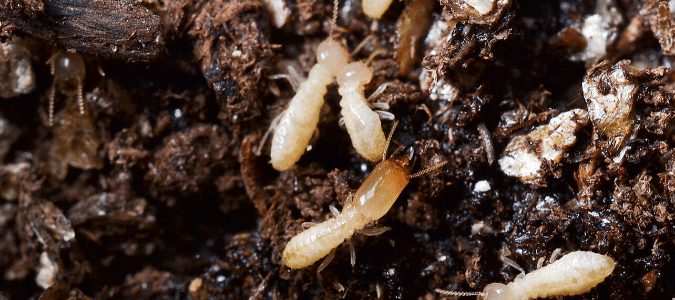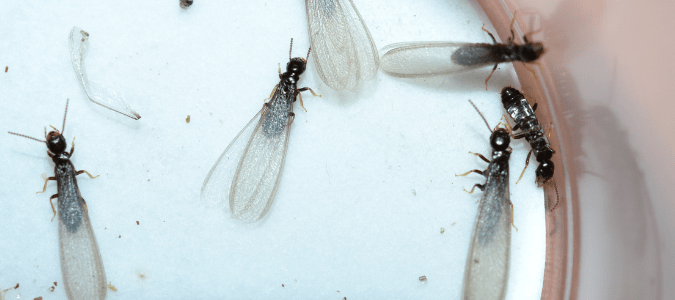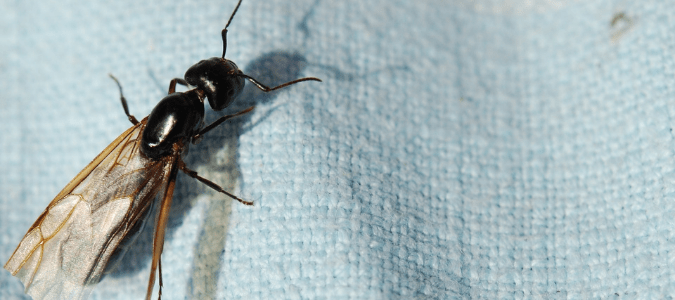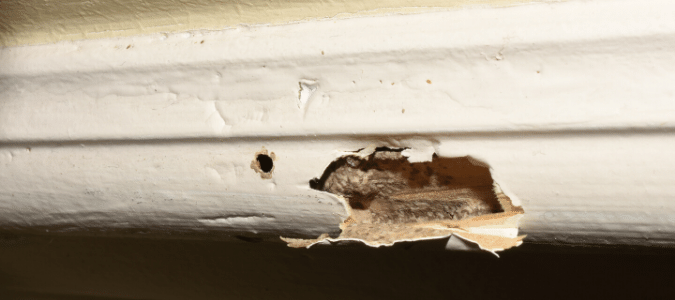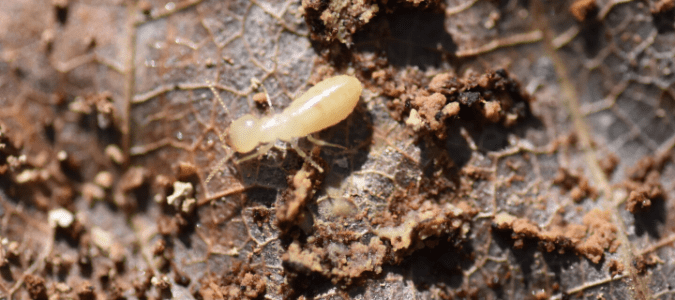Subterranean termite damage costs American homeowners billions of dollars every year. These pests are discreet and it’s hard to spot the signs of an infestation unless you’re a trained professional. Many times, homeowners are unaware a problem has developed until a full-blown population has been established. So, what can you do if you think you have a subterranean termite problem or want to prevent a termite problem?
The first step to determine if there is a problem is to learn more about subterranean termites. It helps to understand the appearance, behavior and signs of these pests.
What Do Subterranean Termites Look Like?
Subterranean termites are separated into three different castes: reproductives, workers and soldiers. The reproductives include the king, the queen and the winged alates. The queen is the largest termite in the nest. She stays hidden underground, so you will likely never spot her. The alates, which are pictured above, are also known as swarmers and they have long, dark brown to almost black bodies with translucent wings. Winged subterranean termites are usually a quarter of an inch to a half-inch in length. They can occasionally be mistaken as winged carpenter ants, however there are some differences between the two.
As you can see in the image below, the waists of ants curve inward and then outward, whereas adult subterranean termites have long, straight bodies. The antennae of termites are also straight, while ants’ antennae look like an arm bent at the elbow. Both ants and termites can have wings, but the wings of subterranean termites are the same size and ants have different wing sizes.
Worker and soldier termites, which are pictured at the very top, are usually a creamy white color. Workers are about a quarter of an inch in length or less and have small jaws to help them chew through materials. Soldiers, on the other hand, have large mandibles and their bodies are flat and wide. Their rectangular-shaped heads are typically a darker brown color than their bodies.
Common Signs of Subterranean Termites
As previously mentioned, it can be difficult to spot the signs of a termite infestation, especially because some of these signs can be confused as other things. For example, it can be difficult to tell the differences between termite damage and wood rot. However, there are a few things you can look for that will help you determine that you are dealing with termites.
Subterranean termites need moisture to survive. They create tunnels made of soil, wood and their own feces so they can travel between the nest and their food source, which is typically a home, shed or other wooden structure. These thin tunnels, also called mud tubes, are about the width of a pencil and can typically be found on the exterior of the home.
Another sign of subterranean termites is soft wood that sounds hollow when tapped. This can be a sign that subterranean termites have been eating away at the wood underneath. You may also see darkened or blistered pieces of wood and peeling or bubbling paint.
The most apparent sign of a subterranean termite infestation is the appearance of flying termites. Once a termite colony has reached maturity, the reproductives will leave the nest to start a new colony. These winged termites will fly out of the nest, find a mate and look for a place to start a new population of termites. While witnessing a termite swarm can feel scary, these pests usually swarm for a few minutes before finding a mate and losing their wings. Additionally, winged termites won’t cause you or your family harm. However, this is a sure sign that termites are active on your property.
How To Identify Subterranean Termite Damage
Subterranean termites feed on wood and other materials that contain cellulose. For example, termites can feed on paper, some fabrics, cardboard and fiber insulation. These unwanted guests eat 24 hours a day, 7 days a week.
If you are sharing your home with a subterranean termite colony, you may be hosting millions of worker termites. Unfortunately, these pests are eating away at your most valuable asset: your house. These unwelcome guests thrive in the warm, damp and dark places under your home.
If left undetected, subterranean termites may be hard at work destroying the foundation of your house for years. It is crucial to catch termite damage before it becomes unrepairable. Homeowners can take steps to detect termite damage early on. Because termites eat through the inside of wood, they often leave the exteriors untouched.
To detect potential damage, try knocking on wooden structures in your home, especially the basement. If you hear a hollow sound, there may be termite damage. You can further explore by stripping away some of the wood’s exterior to see inside. Inside you may see where the subterranean termites have tunneled through the wood.
Where to Find Subterranean Termite Damage
Check for subterranean termites’ mud tunnels on the exterior of your home or in your basement. Examine window sills for swarmer wings. Tap various wooden surfaces around the house to see if they sound hollow.
Another place some subterranean termites like to hang out is inside your walls. One species, the Formosan termite, will construct termite mud nests of wood and excrement, hollowing out your walls. If there are subterranean termites living in your walls, their nests are wet and soft.
Unfortunately, it is not easy to check the insides of your walls for subterranean termites. When you do it yourself, you can end up causing more damage to your home.
As a busy homeowner, checking the inside and outside of your home for subterranean termite damage can feel like one more thing on your to-do list. That’s why so many homeowners turn to pest control professionals. Professionals can inspect and protect homes from subterranean termites. Regular inspections and monitoring can keep termites away from your home.
How To Get Rid of Subterranean Termites
There is no reason to be embarrassed about subterranean termites in your home. This problem happens to many homeowners in Texas and Florida each year. If you discover subterranean termite damage, it’s important to contact a pest control professional as quickly as you can.
Subterranean termites live underground and attack your home in dark and difficult-to-reach places. This is part of the reason why store-bought chemicals and home remedies don’t work for termites.
If you are wondering how to get rid of subterranean termites, there is not much you can do to stop the growth of an existing colony by yourself. The more time you spend trying to resolve this issue on your own, the worse the infestation will get. To prevent further damage, contact termite control professionals as soon as possible.
When you contact professionals, they will be able to answer all of your questions and can schedule an inspection right away. Then, when they examine your home, they will provide an estimate for your customized termite treatment plan. Licensed pest control experts will efficiently treat your home. They will target areas where subterranean termites may enter your home. These treatments will eliminate the termites and stop them from reproducing. Finally, most professionals offer an ongoing monitoring program. With this program, the professionals will put a prevention plan in place that includes regular inspections to protect your house from future damage.
Preventing Future Termite Infestations
Are you worried that your home may be vulnerable to subterranean termites? We can recommend some simple steps to help prevent subterranean termite damage.
Avoid storing lumber or other types of wood near your house. Check your gutters and downspouts for blockages so that you can keep water flowing away from your home. Landscape your lawn in a way that creates channels for excess water so that puddles do not form. Fix any leaking water and plumbing issues and remove trees from your yard that are infested with termites.
For additional tips on preventing subterranean termites, contact a professional pest control service.
ABC Can Control and Prevent Subterranean Termites
Subterranean termites can cause extensive damage to your home. When you contact ABC Home & Commercial Services, you can have peace of mind that your biggest investment is protected. We offer scientifically proven methods of termite control. In addition, we offer ongoing termite monitoring services so we can catch the early signs of an infestation before a colony becomes established.
